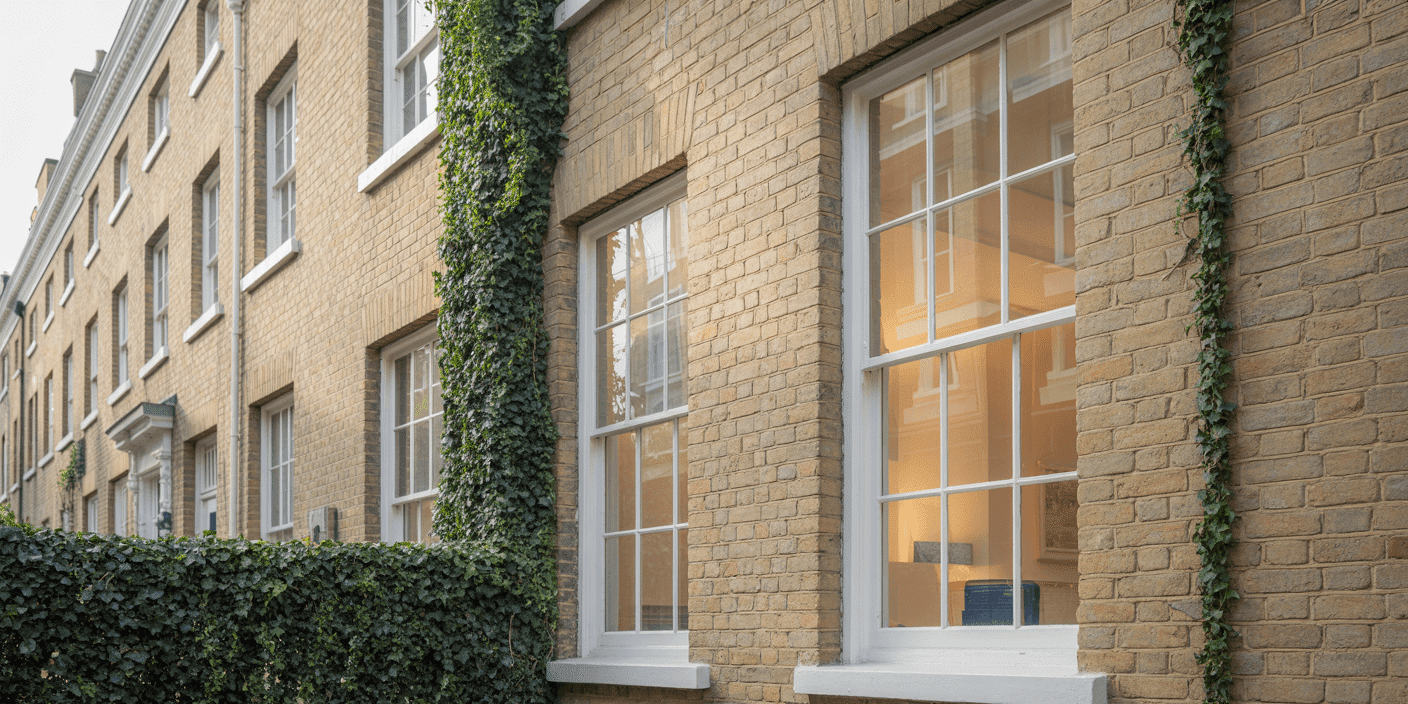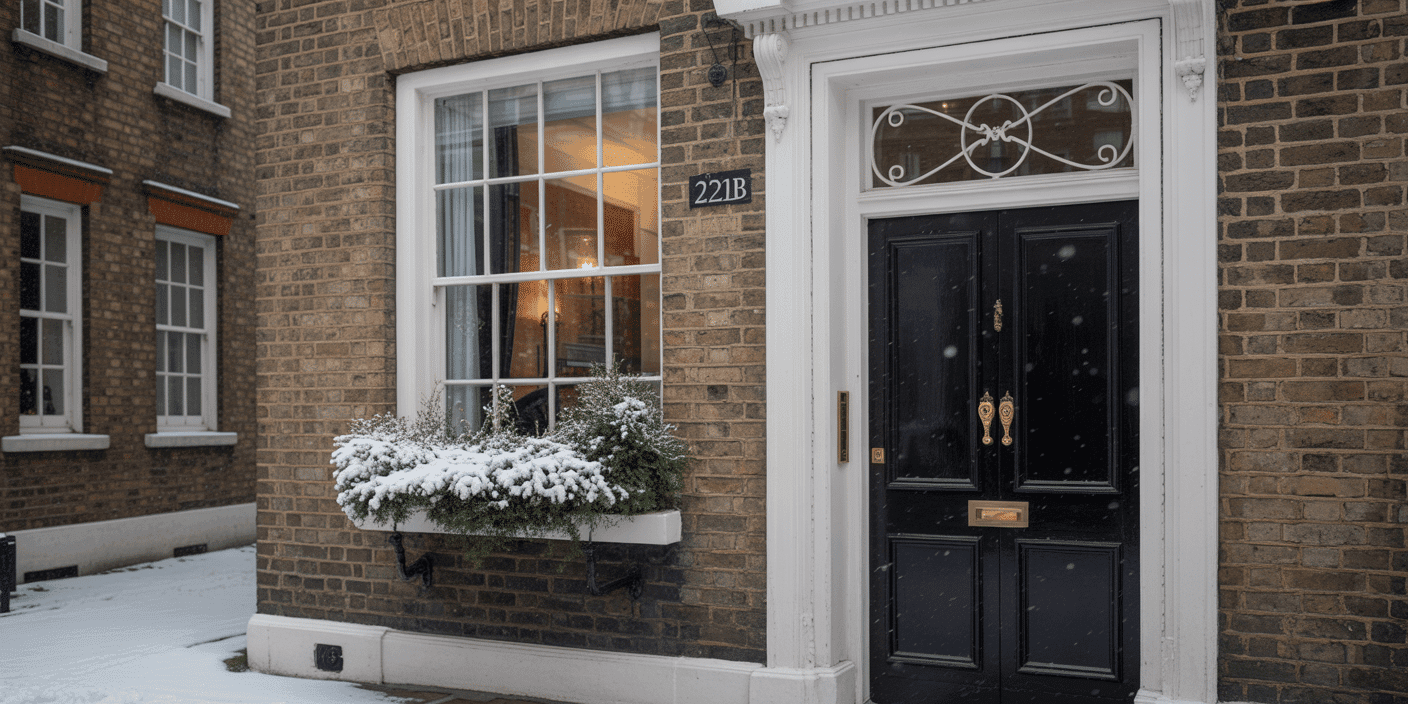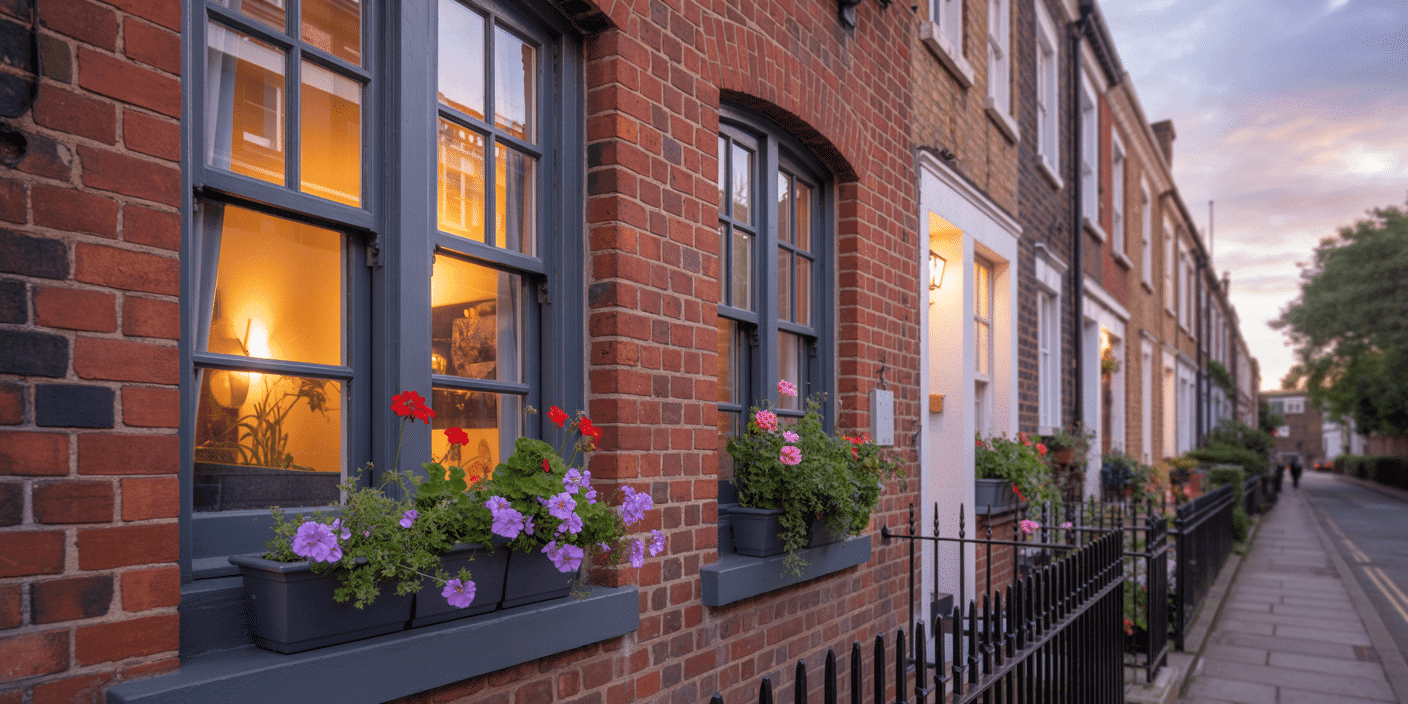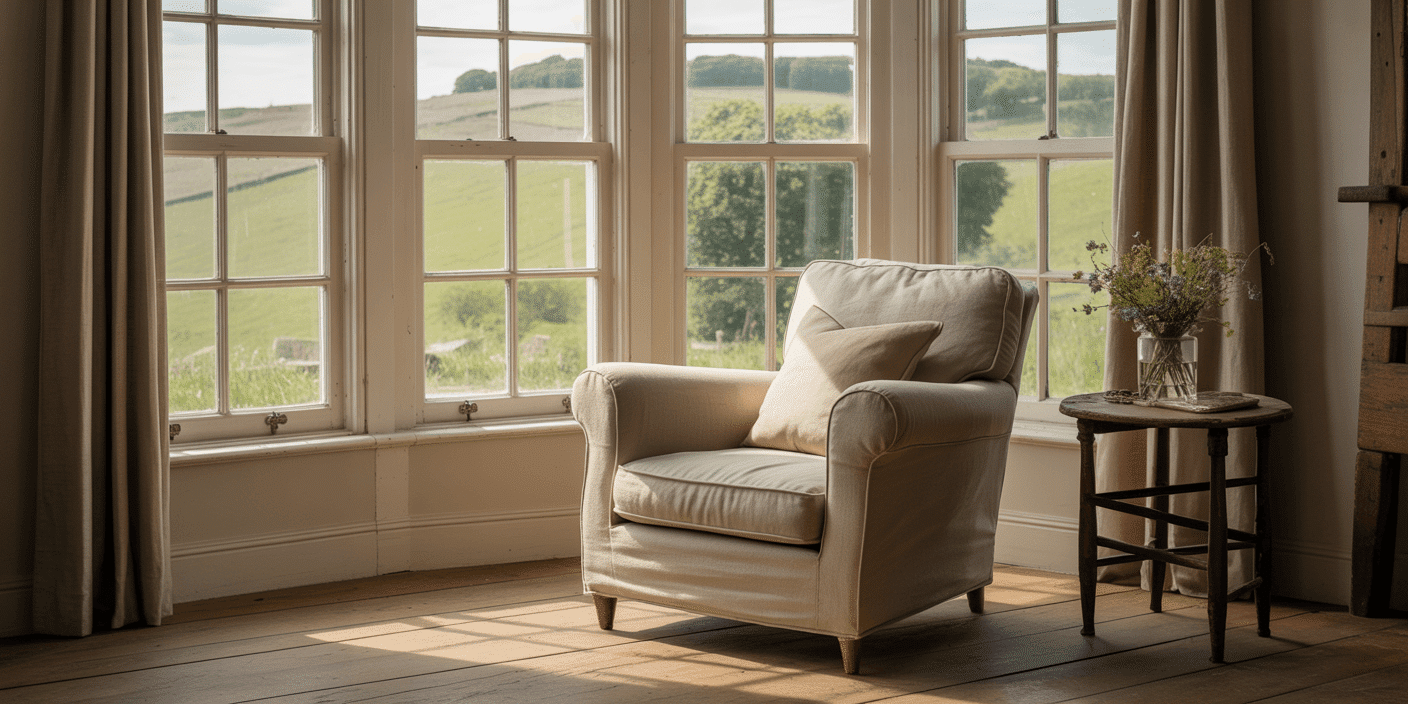The Great Window Fallacy
— Where tradition is too often underestimated.
Conventional wisdom insists that timber sash windows are charming, yet inefficient. Visually elegant, but technically obsolete. A sentimental choice suited only to listed buildings and Georgian façades.
This is not just outdated thinking — it is objectively incorrect.
Modern timber sash windows are no longer relics of the past. They have been re-engineered, refined, and quietly revolutionised to meet — and often exceed — the performance benchmarks expected in today’s homes.
Where they once allowed draughts, they now seal with precision.
Where they once leaked warmth, they now offer certified thermal containment.
Where they once required constant upkeep, they now resist the British climate with long-term coatings and dimensionally stable cores.
The myth persists not because timber cannot deliver, but because most examples still seen today lack proper execution. Poor-quality softwood, inadequate seals, and cost-cut joinery have tarnished the perception of what timber can achieve.
But true craftsmanship never failed. Compromise did.
Across London’s most sensitive conservation projects and exciting new developments, a new standard has emerged — one that honours architectural heritage while embracing advanced performance.
Designed to comply. Built to last. Trusted by planners. Chosen by homeowners who refuse to compromise.
Beauty Forged in Tradition
— What history shaped, performance perfected.
The timber sash window isn’t just a product — it’s a portrait of British architectural identity. From the elegant townhouses of Belgravia to the Georgian terraces of Islington, its proportions are more than pleasing — they’re mathematically balanced, born of the Golden Ratio, and refined through centuries of craft.
Its presence speaks of restraint, of dignity, of detail that whispers rather than shouts.
But heritage alone doesn’t hold heat. And beauty, by itself, can’t block sound or satisfy a building inspector with a clipboard full of Part L regulations.
That’s where the myth sets in — the idea that if you want comfort, efficiency, or durability, you must compromise the charm. That sash windows belong to a past we’ve moved on from.
This is where Sash Windows London quietly rewrites the narrative.
Because they didn’t start with a plastic extrusion or a factory spreadsheet. They started with the original — then asked: “How do we preserve this silhouette while engineering out its weaknesses?”
They didn’t redraw the frame. They reinforced it with invisible technologies:
- Hidden brush seals to block the draughts
- Engineered timber cores that resist warping
- Glazing units that preserve the sightlines while smashing performance targets
This isn’t a reproduction. This is heritage, reengineered.
The result? A window that honours the past but answers to today.
The look remains unmistakable — slim glazing bars, authentic profiles, horn detailing where needed. But behind that elegance is acoustic control, thermal containment, and security certification to modern standards.
It is design that respects its lineage while demanding nothing of your comfort.
Because the homes we love don’t deserve excuses. They deserve windows that love them back.
Silence, Warmth, and Strength

— The anatomy of modern performance hidden in plain sight.
What if the most beautiful window in your home was also the most technically advanced?
What if it didn’t just look traditional — but also locked in warmth, kept out noise, and stood firm against intrusion, all without compromising its character?
That’s the paradox modern timber sash windows resolve — and it’s where Sash Windows London operates at their most exacting.
Silence: Acoustic mastery for the modern city
London is a city of echoes — traffic hum, aircraft overhead, distant voices on damp pavements. Yet inside a Sash Windows London installation, there’s only calm.
By combining precision brush seals with acoustic-grade glazing and engineered sashes that close with airtight integrity, these windows reduce ambient noise to a hush — even with traditional sightlines fully preserved.
“Our triple brush-seal system and laminated acoustic glass don’t just meet expectations. They dissolve the city outside.”
Warmth: Thermal performance built into every joint
Forget the image of draughty, rattling sashes that bleed heat into the winter air.
Today’s high-performance timber sash windows use:
- Low-emissivity (Low-E) coatings to reflect radiant heat
- Argon-filled double or triple glazing for thermal resistance
- Warm-edge spacer bars that prevent cold bridging
- Fully insulated meeting rails and sill sections
All delivering U-values that rival or exceed new-build standards — without changing the window’s classic lines.
“We’ve put the sash window through the thermal lens — and brought it into the 21st century, quietly outperforming even many aluminium systems.”
Strength: Security with subtlety
Security doesn’t have to mean steel bars or PVC locks. With PAS24-rated multi-point locking, laminated safety glazing, and robust engineered timber cores, Sash Windows London windows deliver:
- Resistance to physical force
- Compliance with Part Q security standards
- Invisible protection with no compromise to aesthetics
Whether for a Belgravia townhouse or a Camden conservation terrace, these windows bring quiet strength to traditional form.
“You won’t see the security. You’ll just feel it every night you sleep soundly.”
This isn’t surface-level improvement. It’s total window redefinition — where performance is built into every millimetre, invisible to the eye, but impossible to ignore once you live with it.
Because true luxury isn’t loud.
It’s silence, warmth, and strength — in perfect balance.
Why Timber Has Evolved
— From softwood to science.
For decades, timber was treated unfairly — dismissed as quaint, high-maintenance, and unreliable in a wet British climate. Paint flaked, joints swelled, sashes stuck. The problem wasn’t the concept; it was the material. Builders used softwood that was never meant to last, coatings that couldn’t breathe, and short-term thinking that made long-term maintenance inevitable.
But timber has evolved. Quietly, radically, and scientifically.
Today, modern engineered timber—the kind Sash Windows London insist upon—has nothing in common with the frames of the past. It’s not cut from raw planks; it’s engineered, stabilised, and treated to the molecular level to endure the elements for decades.
Accoya, Red Grandis, and Engineered Oak: the new timber trinity
- Accoya is modified radiata pine—acetylated to resist moisture, insects, and rot. It won’t warp, swell, or shrink, even in the erratic humidity of a London winter.
- Red Grandis, a fast-growing, sustainable hardwood, delivers strength, fine grain, and dimensional stability.
- Engineered Oak, crafted from multiple bonded layers, prevents movement and enhances resilience without losing that unmistakable oak grain and tone.
Each of these timbers offers a 50-year guarantee against rot—something even aluminium can’t promise without coatings.
Micro-porous coatings: paint that breathes
Gone are the days of heavy gloss and cracking paint. Sash Windows London use factory-finished micro-porous coatings, applied in controlled conditions.
They expand and contract with the timber, letting moisture escape while sealing out water.
The result?
No peeling. No bubbling. No Sunday repaints.
Just a finish that stays elegant for years — even under London rain.
“Our coatings last so long you’ll forget what maintenance used to mean.”
Precision joinery meets modern protection
Every joint, groove, and seal is CNC-cut for dimensional perfection.
Silicone gaskets and weather seals are built in, not retrofitted.
Drainage paths are engineered to channel water away — the kind of detail that turns longevity from theory into habit.
It’s not “timber versus technology.”
It’s timber empowered by technology.
Sustainability by design
While uPVC and aluminium depend on fossil-based or high-energy production, timber is renewable, recyclable, and carbon-storing. Every frame locks away carbon for decades — a literal climate-positive contribution.
For architects and homeowners pursuing sustainability or Passivhaus-level performance, modern timber isn’t just compliant — it’s conscientious.
Today’s timber sash windows are the opposite of old-fashioned.
They’re engineered, warranted, and verified — built for both heritage and high performance.
The only thing left that’s traditional… is the elegance.
Built for the Rulebook
— When heritage passes with flying colours.
In today’s world of ever-tightening regulations, windows aren’t just architectural features — they’re critical performance components. Whether you’re restoring a Georgian townhouse or building new within a conservation area, your windows have to do more than look the part. They need to pass the tests.
At Sash Windows London, every detail is engineered not just to meet, but to exceed the demands of British building regulations. Because when heritage is handled properly, compliance becomes seamless — not stressful.
Part L — Thermal Efficiency
Energy performance is no longer optional. Part L mandates minimum thermal performance (U-values) to help reduce carbon emissions and household energy loss. And yes — timber sash windows can pass.
- Double or triple glazing with argon gas fills
- Low-E coatings and warm edge spacers
- Precision brush seals and insulated meeting rails
These aren’t retrofits. They’re standard in every modern Sash Windows London unit.
“Our sash windows achieve U-values as low as 1.1 W/m²K — easily exceeding Part L for replacement works.”
Part Q — Security for New Builds
If you’re building new, your windows need to resist intrusion — and prove it. Part Q sets clear requirements for security through tested products.
Sash Windows London integrates:
- PAS24-compliant locking mechanisms
- Laminated or toughened glass
- Reinforced timber cores that resist forced entry
All while maintaining period sightlines. No visible steel. No clunky locks. Just invisible strength, woven into heritage form.
“Looks like 1802. Performs like 2025.”
Part K — Safety Glazing
Wherever windows are low to the floor, above staircases, or at risk of breakage, Part K requires safety glazing.
- All sash units from Sash Windows London come with toughened safety glass as standard in risk areas
- Optional laminated glass offers extra security and acoustic protection
No compromises. No retroactive swaps. Just correct, compliant design from day one.
Planning & Conservation: Getting Past the Gatekeepers
Planning officers, especially in London’s conservation boroughs, can be notoriously selective — and rightly so. They’re the guardians of Britain’s architectural soul.
But here’s the good news:
Sash Windows London has built a reputation within planning departments. Our profiles, horn detailing, sightlines, and glazing options align with heritage expectations — without sacrificing performance.
“We’ve had our sash profiles pre-approved in multiple conservation areas across Greater London.”
It’s why architects recommend us before the spec is even finalised.
This is how modern sash windows win on paper and in practice. Not just beautiful, but legally robust.
Not just compliant, but future-proof.
Because heritage doesn’t mean compromise — when it’s designed to meet the rulebook with elegance.
The Pretenders

— What the others promise, and what they quietly miss.
Not all windows are created equal. Especially not when you’re balancing period aesthetics, modern regulations, and long-term value.
Walk down any street and you’ll see the signs: faux sash styles made of plastic, bulky aluminium frames in mock-period properties, and composite systems that try to be everything — and end up being nothing special.
These are the pretenders — each offering a sliver of the solution, but missing the essence entirely. And while they may seem practical on paper, the lived experience tells another story.
uPVC: the disposable decision
Plastic-framed sash-lookalikes often sell on price. They mimic the proportions — sort of. They tick thermal boxes — temporarily. But they lack finesse, longevity, and soul.
- Chunky profiles break the illusion of slim timber lines
- Welded joints expose the fact that it’s plastic, not craft
- Lifespan? Around 15–20 years before discolouration and warp
- Unsuitable for many conservation areas and period homes
Worst of all, they may look “done” on day one — but within a decade, they’ve lowered the tone and the value of the home they were meant to enhance.
“uPVC may be cheap at checkout, but the real cost is always long-term — in kerb appeal, compliance, and performance.”
Aluminium: cold precision, little charm
Aluminium windows are slick. Sharp. Engineered. And totally out of place on most heritage homes.
Yes, they deliver slim sightlines and excellent strength. But:
- Their surface is cold — visually and literally
- They often require thermal breaks to mitigate condensation
- Acoustic performance is middling without extensive (and expensive) upgrades
- Very few sash-style aluminium windows pass as authentic
They suit modern architecture. But they clash with Georgian, Edwardian, or Victorian character — no matter how well they’re powder-coated.
“What’s the point of elegance, if it never feels warm to the touch?”
Alu-clad / Composite: the hybrid that can’t commit
Composite windows — timber inside, aluminium outside — are a clever compromise on paper. But that’s the problem: they’re still compromises.
- Aesthetic: sleek, but distinctly modern
- Weight: heavy, with thicker sections to support dual materials
- Maintenance: yes, the outer shell protects — but what happens when the inside ages?
- Authenticity: never truly accepted in conservation schemes
They work in new builds. But for period properties? They announce themselves as impostors.
“Composite tries to do everything. In doing so, it forgets why people fell in love with timber in the first place.”
Where the alternatives fall short, Sash Windows London steps in — not to compete, but to restore balance.
We don’t offer compromise. We offer continuity: the grace of heritage, married to the rigour of engineering.
This isn’t about outperforming the others in one category.
It’s about being right in every category that matters — design, performance, planning, and legacy.
Because windows shouldn’t pretend to be something they’re not.
They should be exactly what the home deserves: beautiful, durable, and unmistakably correct.
The Moment It All Changed
— When doubt gave way to delight.
Emma and James had just bought their dream home: a late 19th-century terrace in Clapham, complete with original cornicing, cast-iron railings, and, unfortunately, single-glazed timber sash windows that hadn’t seen a brush or seal in over 30 years.
They loved the house — but the windows? Cold in winter, rattling in the wind, impossible to open without a crowbar and a curse. Friends told them to rip them out and “just get uPVC” — “It’s what everyone does.”
But something didn’t sit right. “We didn’t buy a period home to fill it with plastic,” James said.
So they searched. And they found Sash Windows London.
At first, they were sceptical — “Can timber really be warm, quiet, and secure?”
Then they visited the showroom.
What they saw wasn’t a reproduction. It wasn’t a compromise.
It was craft — updated.
Sashes that glided with fingertip control. Frames that looked like the original joinery but hid modern insulation and acoustic sealing inside. Glazing that reflected the character of Victorian glass but offered triple-glazed silence.
They were shown exactly how Part L compliance was achieved, how Part Q security was engineered into the locks, how Accoya frames outlived softwood by decades, and how every visible detail — horns, bars, beads — had been matched to heritage specs.
And so they committed. No shortcuts. No fakes. Just proper timber sash windows, reimagined for the life they wanted to live.
The result?
- No more whistling draughts
- Rooms are noticeably warmer and quieter
- A planning officer who praised the conservation sensitivity
- And neighbours who asked: “How did you keep the look, but fix the problems?”
“It was the first time we realised we could have everything — not just period charm, but peace, warmth, and security too.”
Today, Emma and James are the ones telling their friends not to settle.
Not to compromise.
Not to fall for imitations.
Because once you’ve seen what’s possible — once you’ve lived with it — you understand:
A timber sash window done properly doesn’t just change the room. It changes your relationship with your home.
Beauty You Can Feel. Performance You Can Measure.
— The final proof lives in how you live.
So here we are.
You’ve heard the myths.
You’ve seen the alternatives.
You’ve followed the thread — from drafty past to precision-engineered present.
What began as a question — “Can timber sash windows actually perform like modern ones?” — now answers itself:
Yes. And in the hands of the right maker, they can do more.
They can silence a city.
They can insulate a memory-filled room.
They can satisfy planning officers and passive house engineers in the same breath.
They can elevate the value of your home — not just on a spreadsheet, but every time you walk past your own façade.
And they can do it all while staying true to your property’s soul.
This isn’t a sales pitch.
It’s an invitation to come and see, feel, and hear the difference for yourself.
Because at Sash Windows London, we don’t just build windows.
We restore trust in what a window can be — and prove that the timber sash hasn’t been left behind.
It’s been redefined.
Ready to experience the real thing?
Book your Silent Window Audit™ and discover:
- What thermal and acoustic upgrades could look like in your home
- Whether your current windows are costing you more than you think
- How our heritage-approved timber systems meet even the most modern standards
Book a Visit
Request a Quote
Download Our Compliance & Spec Pack
Let your home breathe better.
Let your windows speak softly — and clearly.
Let tradition perform.







